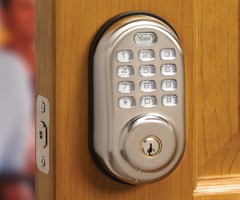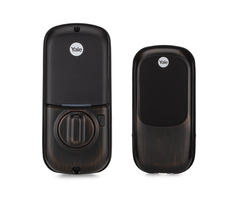How Do I Exclude My Yale Z-Wave Lock?
You can exclude your Yale Z-Wave Lock by putting your system into its Z-Wave exclusion mode and activating the lock's exclusion function. The lock and the Z-Wave controller or hub must be in close proximity when doing this. You should then be able to pair the lock with the Z-Wave network.

Most Yale Z-Wave Locks use similar commands for excluding and including. In most cases, you will put the Z-Wave hub into its appropriate exclusion or inclusion mode and then activate the corresponding mode on the Z-Wave lock. You should then receive some visual indication that the lock has been cleared or included with the network. Clearing the lock first is always best practice, as doing so will ensure that the lock can be paired successfully. And remember, the alarm system will need to have an active Z-Wave controller to support a Yale Z-Wave Lock.
There are a few general rules that apply to nearly any Yale Z-Wave Lock. These locks typically have a Master PIN Code that is configured by the end user. This code is usually four to eight digits in length, and it is used for making changes to the Z-Wave settings. This is also the main code used for locking and unlocking the device on a regular basis. As a result, the end user should be aware of the Master PIN for the device. Keep in mind that this is just a general principle, and it may not apply to every Yale model.
A Yale Z-Wave Lock will either have a settings key (a gear icon) or a [#] key. But it will not have both. The settings key and the [#] key serve the same purpose, and they are used interchangeably when entering commands. For this FAQ, we will refer to it as the [#] key. Just remember that your lock may have a settings key. If it does, use that key when instead of a [#] key whenever it is mentioned in this FAQ.
Anyone with a Yale Z-Wave Lock can expect that the device will follow specific commands for including and excluding. The inclusion command is [Master PIN] + [#] + [7] + [#] + [1] + [#]. The exclusion command is [Master PIN] + [#] + [7] + [#] + [3] + [#]. Remember that the [#] key may be the settings key if your lock has that button instead. Also keep in mind that these are just general codes, and it's possible that some Yale Locks may use a different code. The Yale Lock may need to be in an unlocked state for any inclusion or exclusion command to go through.
Complete the following steps to clear a Yale Z-Wave Lock from a Z-Wave network and then pair it with a network:
1. Enter exclusion mode. Start by putting your alarm system into its mode for excluding devices. The panel will usually have an automation menu for clearing devices and pairing new ones. Alternatively, many external Z-Wave controllers will have a physical enrollment button that will put the module into an inclusion or exclusion mode. You should refer to the manual for your alarm system or its added Z-Wave controller for more information.
2. Clear the lock. You will need to bring the lock into close proximity of the Z-Wave controller during the exclusion process. We recommend a distance of about a foot. Make sure the lock is powered on. Enter the command [Master PIN] + [#] + [7] + [#] + [3] + [#] to put the lock in its own exclusion mode. After entering the command, the lock should send out a transmission. The Z-Wave controller will acknowledge this signal and clear the lock from the network. You should receive some visual indication that a device has been cleared. You will then be able to successfully add the lock to a new Z-Wave network.
3. Pair the lock. Keep the lock close to the Z-Wave controller. Put the Z-Wave hub into its inclusion mode by following the steps outlined in the corresponding manual. Enter the command [Master PIN] + [#] + [7] + [#] + [1] + [#] on the lock. The lock will enter its own inclusion mode and pair with the system. The panel or external Z-Wave controller will provide some visual indication that a new device has been added to the network. Some alarm systems will require you to adjust the lock settings.
Did you find this answer useful?
We offer alarm monitoring as low as $10 / month
Click Here to Learn MoreRelated Products





Related Videos
Related Categories
- Answered


